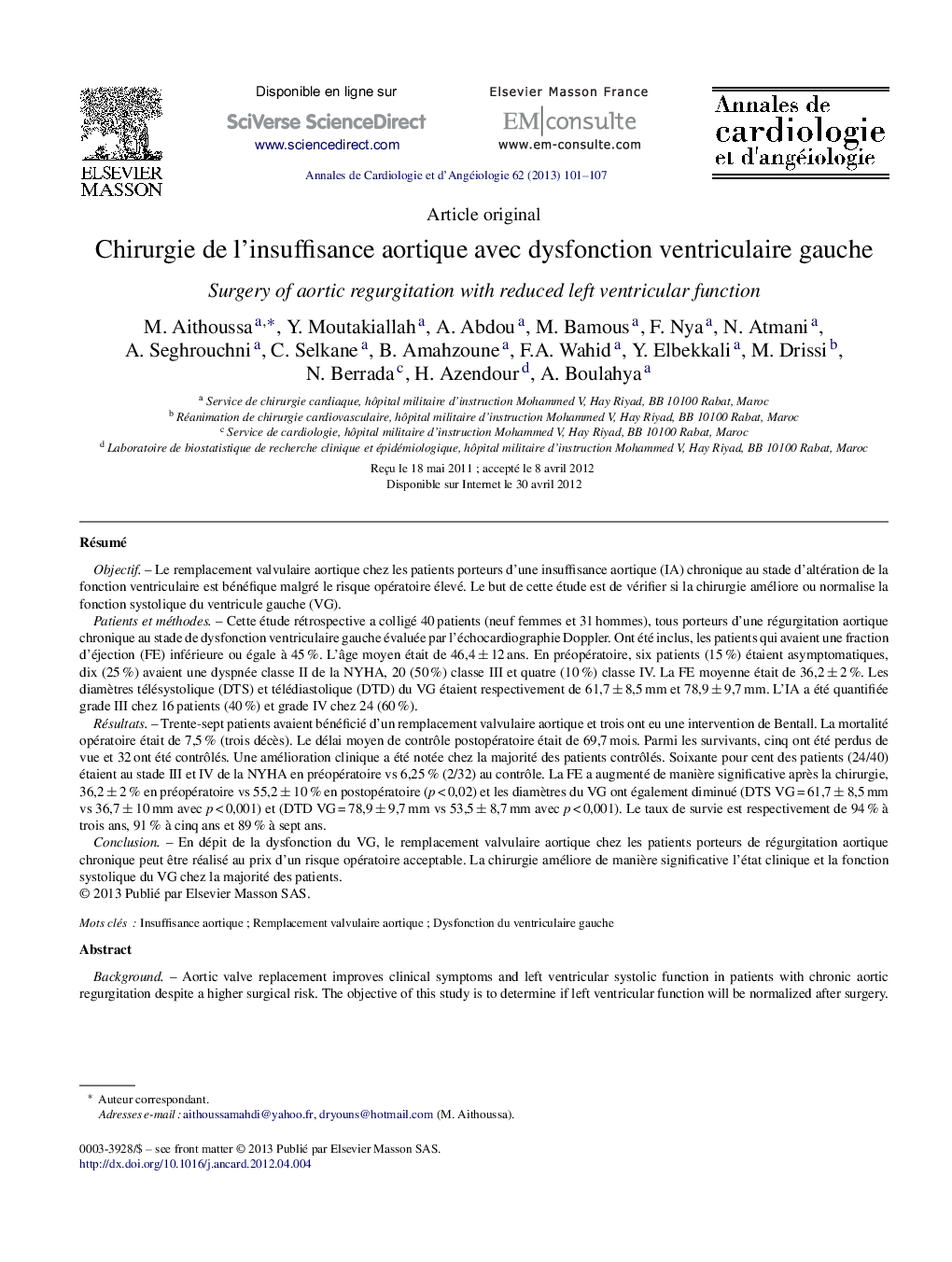| Article ID | Journal | Published Year | Pages | File Type |
|---|---|---|---|---|
| 2869089 | Annales de Cardiologie et d'Angéiologie | 2013 | 7 Pages |
RésuméObjectifLe remplacement valvulaire aortique chez les patients porteurs d’une insuffisance aortique (IA) chronique au stade d’altération de la fonction ventriculaire est bénéfique malgré le risque opératoire élevé. Le but de cette étude est de vérifier si la chirurgie améliore ou normalise la fonction systolique du ventricule gauche (VG).Patients et méthodesCette étude rétrospective a colligé 40 patients (neuf femmes et 31 hommes), tous porteurs d’une régurgitation aortique chronique au stade de dysfonction ventriculaire gauche évaluée par l’échocardiographie Doppler. Ont été inclus, les patients qui avaient une fraction d’éjection (FE) inférieure ou égale à 45 %. L’âge moyen était de 46,4 ± 12 ans. En préopératoire, six patients (15 %) étaient asymptomatiques, dix (25 %) avaient une dyspnée classe II de la NYHA, 20 (50 %) classe III et quatre (10 %) classe IV. La FE moyenne était de 36,2 ± 2 %. Les diamètres télésystolique (DTS) et télédiastolique (DTD) du VG étaient respectivement de 61,7 ± 8,5 mm et 78,9 ± 9,7 mm. L’IA a été quantifiée grade III chez 16 patients (40 %) et grade IV chez 24 (60 %).RésultatsTrente-sept patients avaient bénéficié d’un remplacement valvulaire aortique et trois ont eu une intervention de Bentall. La mortalité opératoire était de 7,5 % (trois décès). Le délai moyen de contrôle postopératoire était de 69,7 mois. Parmi les survivants, cinq ont été perdus de vue et 32 ont été contrôlés. Une amélioration clinique a été notée chez la majorité des patients contrôlés. Soixante pour cent des patients (24/40) étaient au stade III et IV de la NYHA en préopératoire vs 6,25 % (2/32) au contrôle. La FE a augmenté de manière significative après la chirurgie, 36,2 ± 2 % en préopératoire vs 55,2 ± 10 % en postopératoire (p < 0,02) et les diamètres du VG ont également diminué (DTS VG = 61,7 ± 8,5 mm vs 36,7 ± 10 mm avec p < 0,001) et (DTD VG = 78,9 ± 9,7 mm vs 53,5 ± 8,7 mm avec p < 0,001). Le taux de survie est respectivement de 94 % à trois ans, 91 % à cinq ans et 89 % à sept ans.ConclusionEn dépit de la dysfonction du VG, le remplacement valvulaire aortique chez les patients porteurs de régurgitation aortique chronique peut être réalisé au prix d’un risque opératoire acceptable. La chirurgie améliore de manière significative l’état clinique et la fonction systolique du VG chez la majorité des patients.
BackgroundAortic valve replacement improves clinical symptoms and left ventricular systolic function in patients with chronic aortic regurgitation despite a higher surgical risk. The objective of this study is to determine if left ventricular function will be normalized after surgery.Patients and methodThis retrospective study included 40 patients (nine females and 31 males) with chronic aortic regurgitation and left ventricular systolic dysfunction who were evaluated by echocardiography Doppler. Were included patients with left ventricular ejection fraction less or equal to 45%. Ages ranged from 18 to 77 years (mean = 46.4 ± 12.6 years). Preoperatively, six patients (15%) were asymptomatic, ten (25%) were in NYHA II, half (50%) in NYHA III and four (10%) in NYHA IV. The mean preoperative ejection fraction (EF) was 36.2 ± 2%. The mean end systolic and diastolic dimensions were 61.7 ± 8.5 mm and 78.9 ± 9.7 mm respectively. Aortic regurgitation was quantified grade III in sixteen patients (40%) and grade IV in twenty-four (60%).ResultsThirty-seven patients underwent aortic valve replacement and three Bentall operations. Hospital mortality was 7.5% (3/40). The mean follow-up period was 69.7 months. All survivor patients were investigated. Out of these, five were lost and 32 were controlled. Symptomatic improvement was noted in most of the survivors. Sixty percent (24/40) were severely symptomatic before and only 6.25% (2/32) during follow-up. The ejection fraction increased significantly after surgery (36.2 ± 2% in preoperative period vs. 55.2 ± 10% in postoperative period, P < 0.02). Left ventricular diameters decreased significantly also. Survival rates were 3-year 94%, 5-year 91% and 7-year 89%.ConclusionDespite reduced left ventricular systolic function, aortic valve replacement in chronic aortic regurgitation was associated with acceptable operative risk. Surgery improves functional status, symptoms and ejection fraction in most patients.
